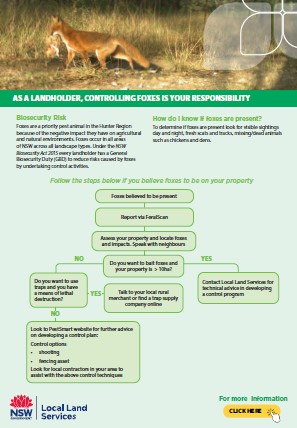
Foxes
Foxes are well adapted to living in semi-rural areas due to the availability of prey and food. This includes rubbish, scraps, native wildlife and your livestock!
About foxes
 They have played a large role in the decline of native wildlife, including small mammals, turtles, lizards and birds. Wait, but there is more – they also carry diseases such as mange and tapeworm, making them a health risk to humans and pets.
They have played a large role in the decline of native wildlife, including small mammals, turtles, lizards and birds. Wait, but there is more – they also carry diseases such as mange and tapeworm, making them a health risk to humans and pets.
Foxes are estimated to cause $227.5 million of damage in Australia each year.
So it is important that small-scale farmers play a role in controlling fox populations, both for the sake of your own property, but also for the wider agricultural industry and environment.
There are options for controlling foxes in peri-urban areas that don’t involve shooting, baits and poisons.
- By removing excess rubbish and available food around your property, you can reduce fox incursions.
- Talk to your neighbours about developing a coordinated approach to the problem. Group control programs are far more effective than working on your own.
- Set up a communication network with your neighbours and use it regularly to identify the scale and nature of the fox problem (i.e. how many sightings and in what locations). Encourage regular observation (fixed cameras), looking for fox scats or direct sightings.
- Look to the PestSmart website for further advice on developing a control plan
The removal of foxes from the landscape is an important part of Local Land Services’ operations. We work with large-scale farming communities on regular baiting programs. But the work you can do in your patch to control this destructive pest is equally important and a valuable contribution to the future of agriculture and the environment.
To better understand your fox control options, download the decision tool. PDF, 295.44 KB
Biosecurity Risk
Foxes occur in all areas of NSW across all landscape types. Under the NSW Biosecurity Act 2015 every landholder has a General Biosecurity Duty to reduce risks caused by foxes by undertaking control activities.
How do I know if foxes are present?
To determine if foxes are present look for visible sightings day and night, fresh scats and tracks, missing/dead animals such as chickens and dens.
Find out more about fox control
- Removing pests from peri-urban areas
- Responsible fox control [539.5 KB PDF]
- Fox control decision tool [295.4 KB PDF]
- Understanding your regional pest plan
- A guide to cage trapping foxes (video)
- Fox control options (NSW DPI)
- Urban fox management (NSW DPI)
- European foxes - the issue, planning and management (PestSmart)
- Glovebox guide for managing foxes (PestSmart)
- Report fox activity (FoxScan)